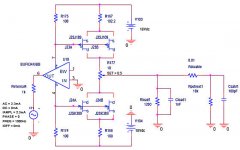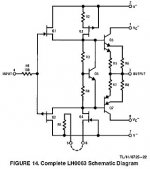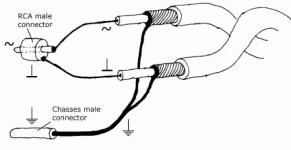Hi i notice
that simple Riv IV converter
do not deliver the corect phase on the output.
With only Riv we can expect 180 degrees phase shift...
same thing is with simple deescrete topologies.
It can be showed with simulation of the classic OP amps
IV conversions present in almost every piece of CD player.
From that simulation I got the real polarity of phase.
(Persuming that the Manufacturers did proper way of 0
degrees phase of output voltage...)
Here is proposal of one
topology which does inverting phase, giving rigt phase at the output
of device
I use BUF634 because of the internal simetry and couple of JFETs
Comments please
that simple Riv IV converter
do not deliver the corect phase on the output.
With only Riv we can expect 180 degrees phase shift...
same thing is with simple deescrete topologies.
It can be showed with simulation of the classic OP amps
IV conversions present in almost every piece of CD player.
From that simulation I got the real polarity of phase.
(Persuming that the Manufacturers did proper way of 0
degrees phase of output voltage...)
Here is proposal of one
topology which does inverting phase, giving rigt phase at the output
of device
I use BUF634 because of the internal simetry and couple of JFETs
Comments please
Attachments
Zoran said:Hi i notice
that simple Riv IV converter
do not deliver the corect phase on the output.
With only Riv we can expect 180 degrees phase shift...
same thing is with simple deescrete topologies.
It can be showed with simulation of the classic OP amps
IV conversions present in almost every piece of CD player.
From that simulation I got the real polarity of phase.
(Persuming that the Manufacturers did proper way of 0
degrees phase of output voltage...)
Here is proposal of one
topology which does inverting phase, giving rigt phase at the output
of device
I use BUF634 because of the internal simetry and couple of JFETs
Comments please
Woooooow you can hear the phase!? Respect!
Actualy
Yes. The inverted phase can be easely recognised
(I was truy, it is clear only one on one fast test)...
The inverted phase from the DAC IV can be useful
only in case of preamplifier does the same thing too...
Most light poor designed (99%) tube preamps,
that is bring phase to 0...
But still hot signal traveling throught the about 1m
of interconnect cable.
For propper connection in that case We must have
2 x coaxial cable per chanel, ground and hot goes through separate wires
and booth shirms are merged and connected to onlu one side lets say dac side to chasis...
Yes. The inverted phase can be easely recognised
(I was truy, it is clear only one on one fast test)...
The inverted phase from the DAC IV can be useful
only in case of preamplifier does the same thing too...
Most light poor designed (99%) tube preamps,
that is bring phase to 0...
But still hot signal traveling throught the about 1m
of interconnect cable.
For propper connection in that case We must have
2 x coaxial cable per chanel, ground and hot goes through separate wires
and booth shirms are merged and connected to onlu one side lets say dac side to chasis...
I mentioned IV buffers
that is clear Buffer leaves phase as at the input
because of that is "Buffer".
But that is not whole IV converter circuit, just I recever lets say
When I mention that before I think on IV con generaly...
Sorry I did not have in mind to hurt enybody...
that is clear Buffer leaves phase as at the input
because of that is "Buffer".
But that is not whole IV converter circuit, just I recever lets say
When I mention that before I think on IV con generaly...
Sorry I did not have in mind to hurt enybody...
Jocko Homo said:Those of us who make non-inverting I/V stages, and are lazy, invert the data going into the filter chip............
Some disagree that it is that easy (not me btw).
Zoran said:But still hot signal traveling throught the about 1m
of interconnect cable.
Still trying to understand what you mean with that.

Elso is joking about the out by one error of inverting all the bits to effect an inversion of phase. (This has been done to death in older threads - but very briefly, I2S (and most digital sources) use what is effectively 2's complement representation. Flipping all the bits gets you the 1's complement representation negation - to do the last step you should add 1. This is clearly trivial in the extreme - and in the nature of music - a meaningless error.)
I made one simple IV
using already matched
transistors in symetrical buffer devices...
I think that this kind of using buffers IC can be
interesting.
But there we beguin to talk about phase
actualy proper way of phase voltage is zero
with as minimum drift as can acheive...
With respect to more expirenced and educated DIYs,
I am not ready to accept that no difference between inverted phase of signal
and when the signal in-phase...
And about the different way of interconnect cable arangement
just to improve things betwen two stages
for instance DAC with oposite phase and preamp also with
oposite phase, i will send a picture maybe then will more clear...
*
Still waiting for the comments about the schematic topology?
using already matched
transistors in symetrical buffer devices...
I think that this kind of using buffers IC can be
interesting.
But there we beguin to talk about phase
actualy proper way of phase voltage is zero
with as minimum drift as can acheive...
With respect to more expirenced and educated DIYs,
I am not ready to accept that no difference between inverted phase of signal
and when the signal in-phase...
And about the different way of interconnect cable arangement
just to improve things betwen two stages
for instance DAC with oposite phase and preamp also with
oposite phase, i will send a picture maybe then will more clear...
*
Still waiting for the comments about the schematic topology?
As long as you are consistant with the phase (inverted or not inverted) with all channels of audio, it doesn't matter if the sound is inverted or not. Of course if one channel is inverted and the others are not, than you will definately hear a problem!
As electrical signals travel thru cables at about a foot (30cm) per nanosecond (about 2/3 the speed of light), cable length won't have any significant effect on audio phasing. The extra length of cable on a channel may have more capacitive loading on that signal, rolling the highs off some. You will hear that if it's bad enough. And the resulting unintended RC circuit (R being the source impedance, and C the cable capacitence) may cause some phase shifting that you might be able to hear (soundstage skewed to one side some). Use the same length of any decent quality cables for your signals to avoid this (but don't buy the $600 snakeskin woven jacket cables, that's way overkill). And for the speaker cables, just use heavy gauge power cord, ones rated for 15 or 20 amp service.
As electrical signals travel thru cables at about a foot (30cm) per nanosecond (about 2/3 the speed of light), cable length won't have any significant effect on audio phasing. The extra length of cable on a channel may have more capacitive loading on that signal, rolling the highs off some. You will hear that if it's bad enough. And the resulting unintended RC circuit (R being the source impedance, and C the cable capacitence) may cause some phase shifting that you might be able to hear (soundstage skewed to one side some). Use the same length of any decent quality cables for your signals to avoid this (but don't buy the $600 snakeskin woven jacket cables, that's way overkill). And for the speaker cables, just use heavy gauge power cord, ones rated for 15 or 20 amp service.
As long as you are consistent with the phase (inverted or not inverted) with all channels of audio, it doesn't matter if the sound is inverted or not. Of course if one channel is inverted and the others are not, than you will definitely hear a problem!
This is correct. However, not all CD's are recorded the same. This is why some (very good!) DAC's have "phase invert" implemented within a digital domain. Some disks sound better with this switch in ON position. It can be noticed very easily.
Extreme_Boky
Originally posted by Extreme_Boky
This is correct. However, not all CD's are recorded the same. This is why some (very good!) DAC's have "phase invert" implemented within a digital domain. Some disks sound better with this switch in ON position. It can be noticed very easily.
Extreme_Boky
Nothing is really proven here:
"pressing that specific switch on that specific device" makes you hear a difference you state. That's your only "fact".
You need to prove that by pressing that specific switch, the only thing that changes is the phase of your electrical output signal with the constraint it must be done perfectly.
Now proving this may be very hard to do
You need to consider how the final output fase inversion is implemented in your device:
Is it implementd by switching in an inverting stage ?
Now the circuitry changes....
Is it implemented by reversing the output wires in a switch ?
Now the routing of your wiring changes...
Is it implemented by inverting the DATA signal prior to the filter/dac ?
Now the analogue properties of the "digital" DATA signal changes and can influence a downstream chip...
Even with on-chip inversion using a phase invert digital input, it's even possible that you add some jitter as a side-effect as well, resulting from the chip's internal circuitry.
It's all about subtle changes in the analog domain and/or time domain.
So before making hasty conclusions, one needs to be sure and prove he's not changing anything else than phase only before pressing that INVERT button
??????? I am not trying to prove anything to you - phase inversion on both channels makes the difference and it can be noticed quite easily. Some disks show it more, some less. It is usually done in digital domain, just before the DAC chip. This is the easiest way and one that does least harm to the original information.Nothing is really proven here:
"specifics" should be replaced by "phase invert switch" and "DAC". If in doubt check my first reply but this time spend some time reading first before misrepresenting my words and whole sentence."pressing that specific switch on that specific device"
Extreme_Boky
Thx Francis you got it in consended form with as little words as possible! VERY good!Francis_Vaughan said:Elso is joking about the out by one error of inverting all the bits to effect an inversion of phase. (This has been done to death in older threads - but very briefly, I2S (and most digital sources) use what is effectively 2's complement representation. Flipping all the bits gets you the 1's complement representation negation - to do the last step you should add 1. This is clearly trivial in the extreme - and in the nature of music - a meaningless error.)
Gold star for you!
Q from GuidoB
Still trying to understand what you mean with that.
*
next picture showing the
arrangement of cables in let us say
"extended chasis"

For my oppinion this topology can be very
useful between DAC (inverted phase out) and
preamp (inverted phase out).
giving the right phase at the input of the
power amplifier...
Only we need 4 wires of sheilded cable for stereo...
Still trying to understand what you mean with that.
*
next picture showing the
arrangement of cables in let us say
"extended chasis"
For my oppinion this topology can be very
useful between DAC (inverted phase out) and
preamp (inverted phase out).
giving the right phase at the input of the
power amplifier...
Only we need 4 wires of sheilded cable for stereo...
Attachments
Francis_Vaughan said:Elso is joking about the out by one error of inverting all the bits to effect an inversion of phase. (This has been done to death in older threads
I know about the older threads, was in the middle of them...
I did/do not get the joke (OMG?)
Zoran said:Q from GuidoB
Still trying to understand what you mean with that.
*
next picture showing the
arrangement of cables in let us say
"extended chasis"

For my oppinion this topology can be very
useful between DAC (inverted phase out) and
preamp (inverted phase out).
giving the right phase at the input of the
power amplifier...
Only we need 4 wires of sheilded cable for stereo...
How did the cable arrangement answer my question ?
"But still hot signal traveling throught the about 1m
of interconnect cable. ", i gues with the arrangemen as in the picture. But why mention this ?
Must be me going

- Status
- This old topic is closed. If you want to reopen this topic, contact a moderator using the "Report Post" button.
- Home
- Source & Line
- Digital Source
- IV conversion (revisited)


